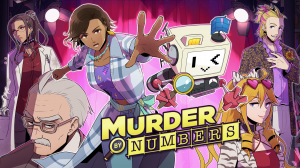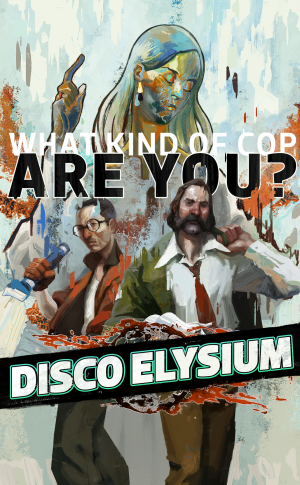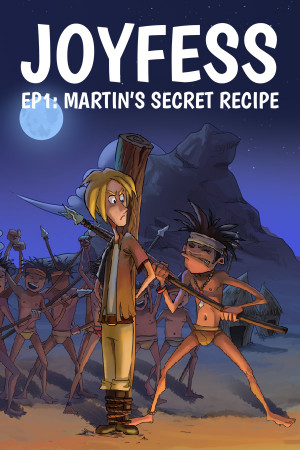Review for Dark Nights with Poe & Munro

Fans of the bi-monthly podcast Welcome To Night Vale may notice a lot of that fictional radio show's horror-stricken town in the surroundings of D'Avekki Studios’ latest full motion video offering, Dark Nights with Poe & Munro. There are plenty of similarities to the work of director David Lynch, and specifically his eerie TV masterpiece Twin Peaks, in there too. But whilst admirers of both will have much to love in Dark Nights, particularly in how far down the rabbit hole of weird it's prepared to go, the hammy acting and unclear choice interface may leave others feeling shortchanged by its emphasis on style over substance.
You play as – or rather make choices for – the titular John Pope or “Poe” and Ellis Munro, returning from the previous FMV adventure from D'Avekki, The Shapeshifting Detective. Hosts of a local radio show in the spooky town of August, the pair end up getting themselves into lots of bizarre situations, whilst still finding enough time to trade innuendos – the duo also being “secret” lovers. (I'm pretty sure Poe's wife has caught on there's a reason he's so keen to keep hosting a radio show that more often than not nearly ends up getting him killed every night, and it's not that he's got a death wish.) Gameplay is split into six episodes, each between ten and thirty minutes long. Helpfully, if that's even too long to sit through in one go, you won't have to restart an episode if you leave it in the middle, but will instead be taken to the last scene you played.
The episodes are mostly standalone, though with the occasional nod to a character you've already met, or something they've said. Each one, often starting with a tip-off or call-in to the pair's radio show, certainly has its own mad twists and turns, ranging from the confusing – a werewolf might be loose in August – to the complex – Munro gets lost inside her own hypnosis. The latter, a highlight, features some notably imaginative storytelling involving a woman getting pushed into a washing machine, which wouldn't be out of place in a Twilight Zone episode.
Each chapter features enjoyably zany details like this to amuse and bemuse, but some don't quite manage to get past the Lynchian trap of being weird at the expense of any actual plot progression. For example, an episode about children going missing in August feels foreboding, with the promise of opening up into a dark whodunit-style mystery. But the explanation for the disappearances ends up making little sense for the story, feeling like a grand idea for an ending rather than one that really works within the context of the episode. There's also an issue of pacing, with a lot to take in and not a lot of time to do so, with even key points tending to get lost in the rush, especially the more new names and characters get added into the mix alongside unexpected plot developments. I found myself left with a collection of strange and often very inventive tales that didn't necessarily make for one engrossing whole.
As this is a live-action game with lots of choices to make along the way, each episode ending gets a Life Is Strange-style summary, recapping the main choices you made and whether you were in the majority or minority of players that picked them. It's a helpful reminder that there are plenty of other paths to explore should you choose to replay. There's nothing that shows, as with similar games like The Complex, how many alternate endings there are per episode or which ones you've already seen, but try them again and you will discover new scenes and lines of dialogue, so there is some value in returning to see where different choices will take you.
Whilst the interface brings a different dynamic of choice than more recent FMV adventures, it's often a vaguer, more confusing one for it. To make decisions, players are given a short amount of time – represented by a disappearing countdown circle – to choose between a number of close-up images. Unlike with other FMV games like Late Shift, there's no direct way to choose dialogue options in Dark Nights, so the images – say, a whistle or a clock – could be something that a character asks about or something they use. It means sometimes having to decipher what it is you're being shown and what selecting it will mean as there's no text explanation, leading to awkward half-guesses and frustration when what Poe or Munro ends up doing isn't quite what you'd imagined.
The developers try to inject some variation into the gameplay by giving certain context-specific options that have a much shorter countdown circle. You’ll need to react quicker to these because there's someone coming towards you with a knife, for example, which keeps you on your toes and paying attention to the drama. Fortunately, by the midway point of the game I'd become more adept at deducing what the images might mean in terms of actions – a weird type of puzzle to work out for an adventure game subgenre that typically doesn't feature puzzles heavily!
The game's soundtrack is mostly made up of brief reflective piano fragments of the main theme, which itself turns into an entire song performed by Poe and Munro near the end of the final episode, an unexpected moment in a large catalogue of unexpected moments in Dark Nights. As for performances, the melodramatic tones can seep into the acting as well as the stories, with Poe's Klemens Koehring particularly doing his best to over-enunciate every line, which does start to grate. But Leah Cunard is fantastic as peppy redhead Munro, sizzling in most scenes she's in and bringing a touch of much needed sarcasm to Poe's earnest advances.
In fact, the dialogue between the pair is on the whole great fun, with some entertaining back and forths. “Careful, you could open a portal to another world!” shouts Poe, only to get Munro's snappy comeback, “I could do with one!” Some of the other cast members don't feel quite as believable: an exchange with a gunman with an incredibly shaky hand almost seems to be played for laughs because of how exaggerated it is. But in general, the chemistry between the main characters, who are rarely off-screen, keeps things entertaining, if a bit overdramatic now and then.
The video itself looks excellent, shot and edited to the same quality you'd expect from a TV series. Most of the action takes place in different indoor locations around town – the radio studio, a hotel room, or a school – but there is the occasional outdoor shot in a forest or by an isolated country road. Some may question the lower budget props and costumes – a large fancy dress rabbit costume, for example – but that slightly kitsch quality only plays into the game's overall camp horror aesthetic, so it actually feels at home with the story rather than jarring against it.
Six reasonably short episodes down the line, or roughly three hours of gameplay later, the player is spit back out of August, a little disorientated and with no real feeling of closure. There's the opportunity to play each episode again and in any order you want, of course, to make different decisions and see slightly different scenes play out. But despite some well-written episodes, slick production values and lively chemistry between the two leads, the game's vague choice system and confusing, sometimes hurried plot lines meant that after a couple of replays I decided to put Dark Nights with Poe & Munro and its creepy, colourful cast to bed.
WHERE CAN I DOWNLOAD Dark Nights with Poe & Munro
Dark Nights with Poe & Munro is available at:
We get a small commission from any game you buy through these links (except Steam).Our Verdict:
A mix of the supernatural and saucy, Dark Nights with Poe & Munro excites with witty exchanges and Lynchian tales that come undone by unclear choice and pacing.



























